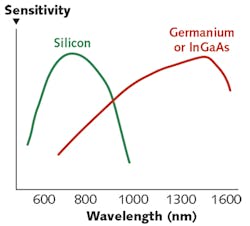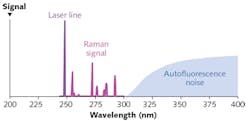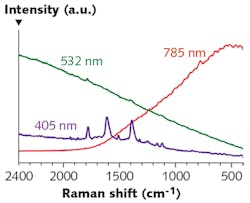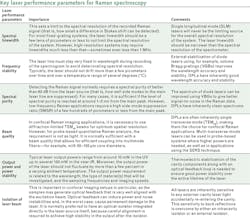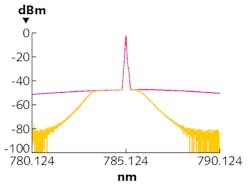How to choose a laser for Raman spectroscopy
Numerous different wavelengths of light are commonly used in Raman spectroscopy, ranging from the ultraviolet (UV) through the visible, and into the near-infrared (near-IR). Choosing the best illumination wavelength for a given application is not always obvious. Many system variables must be considered to optimize a Raman spectroscopy experiment, and several of them are connected to the wavelength selection.
To start with, the Raman signal is inherently very weak. It relies on photon-phonon interactions in the sample material, which is typically a one-in-a-million event. In addition, the Raman scattering intensity is inversely proportional to the fourth power of the illumination wavelength, which means that illumination at longer wavelengths results in a rapidly decreasing Raman signal.
Furthermore, the detection sensitivity is also dependent on the wavelength range. The quantum efficiency of commonly used uncooled silicon-based CCD devices for Raman signal detection rolls off fairly quickly beyond 800 nm. For longer-wavelength illumination, it is possible to use indium gallium arsenide (InGaAs) array devices (see Fig. 1), but these are associated with higher noise levels (and cost) and hence lower sensitivity. Then, there is also the spatial resolution to be considered. The spatial resolution in a Raman imaging application is affected by the illumination wavelength, as the diffraction-limited laser spot diameter is determined by 1.22(λ/4), where λ is the illumination wavelength.
Shorter wavelength lasers: visible or UV?
The wavelength dependence of the Raman signal strength, the detection sensitivity, and the spatial resolution all seem to point towards the use of shorter-wavelength illumination (UV and visible) as opposed to longer wavelengths (in the near-IR). However, there is a major challenge to be overcome with shorter-wavelength illumination: fluorescence emission. Many materials tend to emit a lot of fluorescence when excited with UV-visible light and this fluorescence background tends to drain the weaker Raman signal.
One proposed method for avoiding the influence of fluorescence is called shifted excitation Raman difference spectroscopy (SERDS). This method relies on recording two Raman spectra with two slightly spectrally shifted laser lines, and then subtracting them from each other. In this way, most of the fluorescence signal, which is not as strongly wavelength-dependent, can be eliminated.
For some materials, the influence of fluorescence can effectively be avoided by using even shorter wavelengths in the UV spectral range (see Fig. 2). Although UV light tends to excite strong fluorescence, it is typically emitted at wavelengths above 300 nm. This opens up the opportunity to both excite and record the Raman signal below 300 nm without influence of the fluorescence, as the Raman signal is recorded very close to the illumination wavelength.However, another important aspect to take into account when selecting illumination wavelength is, of course, the availability of suitable laser sources. Factors such as size, performance, stability, and cost must be considered. UV lasers, for instance, are still relatively costly and bulky. Another challenge with UV illumination is that the high energy of UV photons can be destructive to the sample, especially for solid-phase materials, and that UV-enhanced CCD cameras are costly. So, in many cases, red or near-IR lasers (660–830 nm) are still used for fluorescence suppression in Raman spectroscopy, even if the Raman-scattering efficiency is much weaker in the near-IR.
UV lasers are attractive for resonance Raman spectroscopy on biomolecules such as proteins, DNA, and RNA. For applications with very fluorescent materials that require near-IR illumination, it is common to use a 1064 nm wavelength. For instance, 1064 nm has traditionally been used in Fourier-transform (FT)-Raman configurations with a single-element InGaAs or germanium (Ge) detector to avoid fluorescence interferences. FT-Raman, however, is limited by long acquisition times and the need for moving parts. With the availability of sensitive InGaAs array devices, it is now also possible to use 1064 nm lasers with fixed gratings in portable and handheld Raman instruments.
Other important laser-source parameters
In addition to wavelength, there are a number of other important performance parameters that should be taken into account when choosing the best laser sources for a Raman spectrometer. Key performance parameters are: spectral linewidth, frequency stability, spectral purity, beam quality, output power and power stability, and optical isolation (see table).Finally, the compactness, robustness, reliability, lifetime, and cost structure of the illumination are also important parameters to be considered. Raman instrumentation has progressed to becoming a standard analytical tool in many scientific and industrial applications. Users expect to run routine experiments or process-monitoring measurements for years without the need for service or exchange of the laser source. In a growing number of cases, the instrument must also operate in harsh, industrial environments.
For these reasons, most Raman systems nowadays are equipped with solid-state laser sources rather than gas lasers. Compact solid-state lasers with proven operation lifetimes of several 10,000 hours that meet the most advanced optical performance requirements are available in all wavelength ranges commonly used for Raman spectroscopy.
Laser technology
Solid-state based continuous-wave (CW) laser sources commonly used for Raman spectroscopy can be grouped into three categories:
1. Diode-pumped lasers: single-longitudinal mode (SLM)
2. Single-mode diode lasers: distributed feedback (DFB) or distributed Bragg reflection (DBR)
3. Volume Bragg-grating (VBG) frequency-stabilized diode lasers
These laser technologies cover different wavelength regions and have significant differences in optical performance, as explained below.
1. Diode-pumped SLM lasers (DPLs) combined with built-in nonlinear optical frequency conversion are readily available in compact formats from the UV to the near-IR. Up to watt power levels are achievable at 1064 nm in the near-IR. In the visible range, a large number of lines in the blue-green-red region (660, 640, 561, 532, 515, 491, 473, and 457 nm) are available and with output powers on the scale of several hundred milliwatts. Lower power levels are achievable in the UV, such as 10–50 mW at 355 nm. These lasers provide excellent TEM00 beams, very precise wavelengths with low drift, and a single-frequency linewidth of typically far <1 MHz. These lasers also offer a very high level of spectral purity with typically much >60 dB side-mode suppression ratio (SMSR) up to within picometers of the main peak. There may be occurrence of low level emissions at neighboring laser lines, but they are shifted by several nanometers from the main peak and therefore easily eliminated by integrating a dielectric bandpass filter. The wavelength stability is inherently excellent (see Fig. 4).2. Single-mode diode lasers provide very compact and cost-efficient illumination sources with single-frequency linewidth (<1 MHz) and single-transverse-mode beam quality. A number of wavelengths are available in the red to near-IR, with output powers up to a few 100 mW and megahertz linewidth. The most commonly used wavelengths are 785, 830, 980, and 1064 nm. Sideband emission limits the SMSR of these lasers to around 50 dB, which is normally achieved at a few hundreds of picometers away from the main peak.
3. The third group of laser sources for Raman is VBG frequency-stabilized diode lasers. In these lasers, a narrow-linewidth VBG element is used with a diode-laser emitter to achieve narrow-line emission at wavelengths that are not available as DFB or DBR sources. It is also possible to achieve narrow-linewidth emission at higher power levels by frequency-locking multi-transverse-mode diode lasers. Careful thermomechanical control and high-precision alignment inside the laser is required to achieve high stability in the output wavelength and linewidth, especially with varying ambient temperatures. Linewidths range from single-frequency emission to a few tens of picometers, depending on wavelength and output power. And, as with other diode lasers, the SMSR is limited to 40–50 dB close to the main peak. However, this can be improved to 60–70 dB at 1–2 nm away from the main peak by integrating a filter (see Fig. 5).Without a doubt, Raman spectroscopy continues to be a cutting-edge analytical technique that will likely continue to be applied in even more industries and markets in the future. Systems are shrinking, resolution and sensitivity is increasing, and components are becoming more reliable. Understanding the influence of the lasers performance is critical to the continued success within these new application areas.
Acknowledgement
The authors would like to thank Joe Slater, vice president and chief technical officer of Kaiser Optical Systems, An Endress+Hauser Company (Ann Arbor, MI), and Harald Fischer, marketing director at WITec (Ulm, Germany), for input.
REFERENCE
About the Author
Elizabeth Illy
Director of Marketing, Cobolt (HÜBNER Photonics)
Elizabeth Illy is director of marketing at Cobolt, a part of HÜBNER Photonics (Solna, Sweden).
Håkan Karlsson
CEO and Cofounder, Cobolt (HÜBNER Photonics)
Håkan Karlsson is CEO and cofounder of Cobolt, a part of HÜBNER Photonics (Solna, Sweden).
